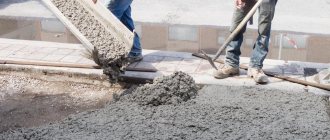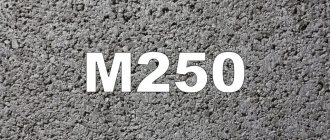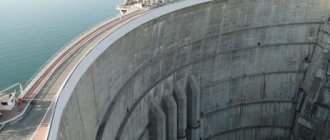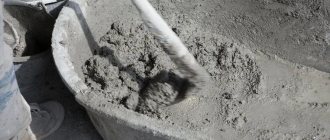Natural stone has always been a strong building material, characterized by a long service life. The cost of such material and construction work using it has always been high, because the bulk of the money was spent on mining and processing stone. For this reason, M350 concrete was created, which is an analogue of natural stone. Due to its qualities, this brand of concrete mortar is an excellent solution for the construction of complex facilities. After hardening, such a composition confidently resists external influences and has high performance, of which compressive strength stands out. Today in the construction industry, concrete 350 occupies a leading position in use and sales.
Characteristics of concrete m350
First, let's study the main technical characteristics of this building material:
- Compressive strength - value measured in mPa, defined by class B25. This means that one cubic meter of concrete mass will withstand a pressure of 25 MPa without allowing the integrity of the structure. An increased strength of heavy class concrete of 25 m350 can be achieved due to the presence of a large amount of cement material in the initial mixture. In addition to strength, this brand is distinguished by other important indicators - resistance to temperature changes, mobility, and moisture resistance.
- Concrete mobility - the value varies between P2 - P4.
- Water resistance - concrete B25 grade 350 has a water permeability indicator W. This parameter means that the material will not allow moisture to pass through even when the liquid exerts strong pressure on the concrete. This quality allows the use of concrete m350 bst v25 p4 f200 w8 in areas where the groundwater level is high. Note that for the same purposes it is also possible to use a less expensive option - concrete m350 f200 w6. For reliability, concrete m350 w10 is used.
- Frost resistance of concrete M350 - the indicator is F200 and means that this material will not lose its qualities and structural integrity after two hundred freeze-thaw cycles. M350 concrete mixture is recommended for use in areas with harsh climates.
- Volumetric weight - this indicator of m350 concrete is 1,800 - 2,500 kg per cubic meter. But often the density of this material varies between 2,200 – 2,400 kg per cubic meter.
Strength can be increased if plasticizer components are added to the concrete mass.
Application of material
Concrete M350 class B25 is used in almost all types of construction. It is used to make floor slabs, monolithic foundations, walls, crossbars, columns, reinforced concrete structures and other structural elements of residential, industrial and administrative buildings that bear heavy loads. Also, airfield road slabs are made from this mortar and are used under conditions of maximum loads.
Let us consider in detail the characteristics that this building material has.
Strength classes
We already know that concrete grade 350 corresponds to class B25. The ratio of the strength of a concrete material of a given grade and class in terms of compressive strength can be presented in the form of a table:
| Concrete grade according to strength indicator | Material Strength Ratio | ||||
| Concrete strength class | Standard grade of concrete mortar | ||||
| All types except cellular | Difference from concrete grade, % | cellular | Difference from concrete grade, % | ||
| M350 | B25 | 327.42 | — 6.45 | — | — |
| M350 | B27.5 | 360.18 | 2.9 | — | — |
What are the advantages of grade 350 concrete?
This brand of concrete has numerous advantages:
- increased strength properties. The concrete mass does not collapse under the influence of significant compressive loads, as well as during active abrasion of the surface during operation;
- high degree of mobility. This makes it easier to carry out concrete work, and the use of special plasticizers can further increase the elasticity index;
- adjustable frost resistance. At the stage of preparing the solution, it is possible to ensure the required level of frost resistance to maintain the integrity of the monolith in difficult conditions;
- long service life. The composition of the M350 brand retains its original strength characteristics for a long time and is not destroyed under the influence of aggressive factors;
- increased density. Thanks to the effective compaction of liquid concrete, there are no cavities or air pores in the mass. This significantly increases the degree of water resistance and expands the possibilities of application;
- environmental cleanliness. For production, environmentally friendly raw materials are used, which do not have a negative impact on people after completion of the hardening process.
Thanks to these advantages, concrete grade M350 has established itself as a universal building material for structural purposes.
Compound
Concrete mortar is a mixture whose recipe is as follows:
- cement material;
- water;
- sand;
- fillers in the form of granite or crushed gravel.
To improve the properties of concrete, plasticizer additives can be mixed into the composition, allowing you to expand the range of use of this brand. One example is concrete w25 p4 m350, which, in addition to the main ingredients, contains plasticizers and additives that improve frost resistance.
It should be noted that the components used in the preparation of concrete mortar differ in parameters and characteristics - particle size, purity, humidity and strength. In one case, the filler can be fine-grained, coarse or medium-grained sand. In addition, M350 concrete can be made on granite. There are known cases when M350 concrete was produced from crushed stone screenings.
Note that the increased percentage of Portland cement contained in concrete class 25 m350 shortens the strength gain schedule of concrete m350.
Influence of component quality
Each component has its own quality requirements.
- Cement. The most common brands on the market are M400 and M500. They do not affect the strength characteristics, but they do affect the proportions, so choose any one. Cement also differs in the amount of additional impurities: D0 and D20. Better and stronger - D0, it does not contain foreign inclusions. D20 contains up to 20% slag and other additives that reduce the quality of cement.
The production date has a significant influence. The shelf life of Portland cement is 3-6 months when stored under ideal conditions. After the time specified by the manufacturer, the cement cakes and lumps form in it, which do not mix.
- Sand. It can be quarry, seeded, washed and river. Regular quarry sand is most often used: it is easy to obtain and cheaper. The disadvantage is the high content of foreign impurities (up to 7%): clay, lime, dust, etc. To improve the quality, quarry sand is sifted or washed. Unlike quarry sand, river sand contains a minimal amount of foreign substances, so it does not need to be additionally sifted.
- Crushed stone. Usually crushed stone of fraction 5-40 is used (depending on the tasks). The use of crushed stone allows you to save on cement and improve the strength properties of the mixture, but the density of the filler should not be lower than the density of concrete. Also, to improve the quality of adhesion to the solution, the crushed stone must have at least 3 edges. Round and flat filler slightly reduce the strength of the product.
- Water. Fresh, relatively clean water is used (without salt, fatty inclusions, dirt, etc.).
Proportions
Let's consider the composition of concrete m350 per 1m3.
To prepare such material, Portland cement is used, the grade of which is at least M400.
The proportions per 10 kg of mass are as follows:
- sand – 15 kg;
- crushed stone of the required fraction - 31 kg.
If M500 cement is used, then 19 and 36 kg of sand and crushed stone will be required, respectively.
If you prefer to make proportions in ten-liter buckets, then the volumetric units of ingredients will be as follows:
- ten thousand cubic centimeters of concrete m200 from cement material m400 will require 14 liters of sand and twice as much crushed stone;
- to prepare the same amount of F100 concrete from M500 cement, take 19 and 36 liters of sand and crushed stone, respectively.
In our case, one cubic meter of fine-grained concrete class 25 m350 is prepared according to the following proportions:
- cement m500 – 400 kg;
- washed sand – 752 kg;
- crushed stone or gravel – 1 t;
- water – 175 l.
By adding up the mass of all components, you can determine the weight of 1 m3 of material. The quality of the future concrete mixture can be judged by the proportions used. The homogeneity of the mass will depend on strict adherence to the mass of the ingredients and their thorough mixing. If these conditions are not met, the concrete does not comply with GOST 26633 and loses strength, which affects the technical properties of the structure.
Composition and proportions for preparing 1 cube
| Ingredients | Cement M400 | Cement M500 |
| Cement | 380 kg | 365 kg |
| Sand | 800 kg | 830 kg |
| Crushed stone | 1080 kg | 1080 kg |
| Water | 155 l | 155 l |
Concrete is ordered from RBU or prepared at home, for which it is convenient to use a concrete mixer. During the cooking process, follow the recommendations:
- The concrete mixer bulb is filled halfway from the container. This will extend the life of the equipment and allow all components to be mixed efficiently.
- First, 30-50% of the required amount of water is poured into the pear, then half of the sand and crushed stone, and only after that cement and the remaining components. This way the mixture sticks less to the walls, and the ingredients are mixed better.
- Do not knead large volumes unless necessary. Due to the high cement content, the mixture sets quickly, and when mixed again, it loses some of its properties.
Preparation of concrete m350
In addition to strictly observed proportions of ingredients, the preparation of the concrete mass must be carried out according to technology.
If you decide to prepare M350 concrete with your own hands, you should use a concrete mixer, which will help give the solution high homogeneity.
Here's a description of the workflow:
- sand and cement are loaded into the concrete mixer, everything is thoroughly mixed;
- water is added in which the additives and plasticizer components used are pre-dissolved;
- after this it is the turn of moistened sand or gravel;
- stirring is carried out until the mass becomes homogeneous.
How long does M350 concrete dry? This question is often asked by consumers. Remember that the setting and hardening time of M350 concrete passes quickly, so the mortar will have to be poured quickly.
If it is not possible to prepare the solution yourself, you can always purchase it ready-made. The cost of the material in this case will be higher, but its quality will not be in doubt. You will save time and money on preparing and transporting concrete, since the supplier will deliver the concrete using special equipment that simplifies the transportation of the material and its pouring.
Areas of use of concrete m350
Concrete material with high strength and good water resistance is used in the production of slabs for floors, airfields and other structures subject to significant loads.
The use of additional components varies over a decent range. For this reason, it is always possible to select the concrete mass taking into account the requirements at a particular construction stage. For example, hydraulic concrete with a sulfate-resistant component is used to pour foundations for multi-storey buildings, and to construct floors, beams and columns. This material is used in the construction of residential and commercial buildings.
Concrete m350 b20 with moisture resistance equal to W6 is classified as heavy mortar. It is used for the construction of cottages, the manufacture of reinforced concrete structures, flights of stairs, sewer wells and other structures that are subject to high tensile pressure.
Due to its high coefficient of water resistance, concrete is distinguished by its ability to resist atmospheric pressure and groundwater. For this reason, concrete is used to construct airfield pavements.
Areas and features of application
Concrete grade M350 is well suited for structures that must have increased strength and durability:
- pouring the foundations of buildings under construction;
- arrangement of staircases;
- pouring load-bearing walls and partitions;
- base for swimming pools;
- pouring reinforced concrete piles in private construction;
- bridge support beams;
- strengthening the road surface.
Concrete grade M350 is an indispensable material in the construction industry, valued for its high-quality composition and strength.











